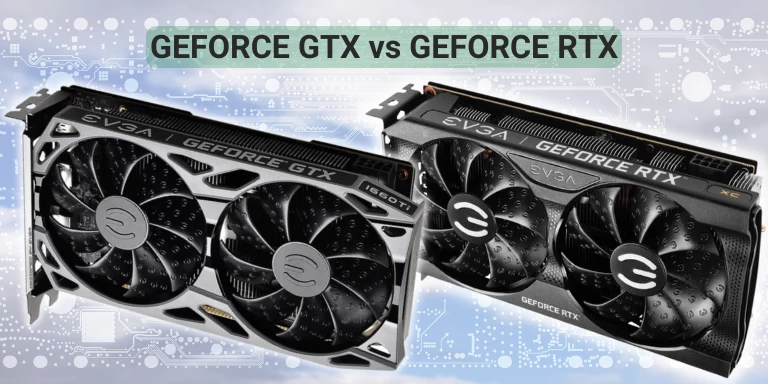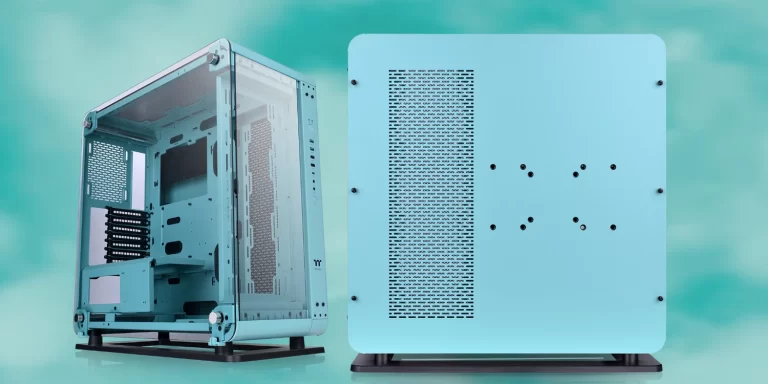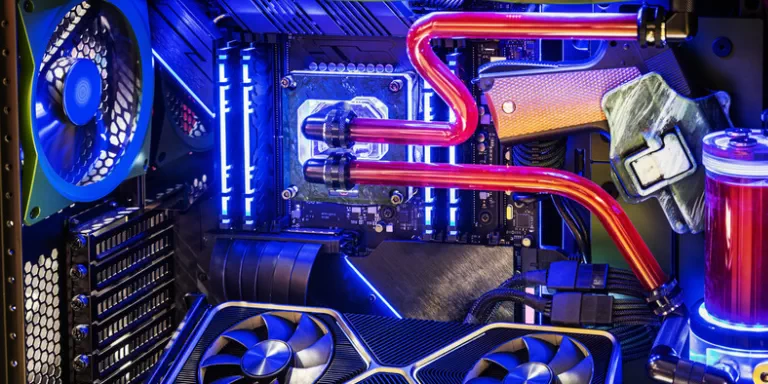When your computer’s graphics card has to perform intensive tasks such as 3D rendering, movie creation, or gaming, it heats up. However, how hot is too hot for GPU?
The normal temperature range for a GPU under load is 149°F to 185°F (65°C to 85°C). So usually temperatures above 185°F (85°C) are too hot for GPU and not safe for them. When this temperature range is reached, the GPU begins to slow down in order to prevent overheating. The image quality will not be accurate as a result.

Excessive heat generated by the GPU will reduce its performance and lifespan. So, you should take preventative measures to keep your GPU from overheating in the long run.
In this article, we will look at some of the topics listed below.
- Why Does My Graphics Card Heat Up?
- What Is Normal Temperature For GPU?
- How Hot Is Too Hot For GPU?
- How Do You Know If Your GPU Is Getting Too Hot?
- Causes of High GPU Temperatures And Fixing Measures
Why Does My Graphics Card Heat Up?
Computer graphics tasks are frequently related to image quality and the number of frames per second that the GPU has to output.
The higher the image resolution, the more pixels are required to display on the screen. The GPU must then perform extensive computation. As a result, temperature of the GPU rises rapidly.
You are a gamer or a filmmaker. Of course, all you want is to satisfy your desires at work or enjoy the thrill of playing video games. You will always expect your graphics cards to be both fast and safe. Also, from here, some kind of questions will be posed:
- What is normal temperature for graphics cards? or What is normal temperature for GPU while gaming?
- What is too hot for a GPU?
- How to control GPU overheating?
These questions will be addressed next.
What Is Normal Temperature For GPU?
Not all graphics cards are made equal. And GPUs of different manufacturers may have different temperature thresholds.
Under normal conditions, the average GPU temperature while gaming is 149°F to 185°F (65°C to 85°C). When playing games, the GPU temperatures can reach 158°F to 185°F (70°C to 85°C). In comparison to Nvidia, AMD GPU has a higher max temperatures. The safe temperature of some AMD GPUs can reach 230°F (110°C).
Average GPU temperature when rendering (3D rendering, movie editing, etc.) is 149°F to 176°F (65°C to 80°C). And under normal load it reaches 131°F to 167°F (55°C to 75°C).
Even if the manufacturer states that the “in Spec.” temperatures can reach above 212°F (100°C), we do not recommend that you maintain that high temperature for extended periods of time. This will quickly overburden the semiconductor materials, resulting in a shorter GPU lifespan.
The ideal temperature range for a GPU under load is 149°F to 185°F (65°C to 85°C).

How Hot Is Too Hot For GPU?
As previously stated, if the temperature exceeds 185°F (85°C), the GPU is considered overheated. If that’s the case, what happens when the GPU overheats? The protection mechanism will then be automatically activated. And it will also lower GPU performance by lowering its clock.
If the temperature continues to rise after the GPU has reduced its own performance, the system will be forced to shut down for safety. And you’ll realize that detecting and acting on GPU overheating early is critical to extending the life of your expensive graphics cards.
In the video below, JayzTwoCents’ testing reveals interesting system reactions when the GPU becomes overheated.
How Do You Know If Your GPU Is Getting Too Hot?
We already know the safe temperature range that the GPU should maintain during work. We will provide some awareness here so that you can detect an overheating GPU early to have reasonable solutions for its long-term survival.
You Hear A Loud Or Overworked Fan
The easiest sign of an overheating graphics card comes from the strain it puts on the rest of the system. If you’re running a game or program that puts your graphic card to the test, it’s typical for the fan to start working and make a bit of noise while it tries to keep things cool.
However, if your fan seems to be running very loudly and for unusual long amount of time, this may be a sign of overheating.
You Experience Decreased Graphical Performance
When the GPU gets too hot, it automatically loses performance during high-intensity programs, resulting in lower frames per second and other undesirable effects. Stuttering or decreased frame rates, difficulty displaying 3D models, freezes, and crashes are typical symptoms of an overheated GPU.
Monitoring GPU Temperatures With Third-Party Software
Operating systems don’t have a built-in live temperature monitor for users to access, the best you can access is a past temperature through diagnostics. The only way to gauge the temperature of your GPU is with third-party software.
Two popular, free third-party programs are HWMonitor or Open Hardware Monitor. These programs can measure GPU (also CPU) temperature and show data relating to temperature trends.
Causes of High GPU Temperatures And Fixing Measures
The main causes of GPU overheating can be narrowed down to a few issues, each with a plausible solution.
Your Computer Needs Internal Dusting or Cleaning
Your GPU relies on fans and coolant to ventilate properly. However, a buildup of dust or pet hair inside your computer is a common culprit of blocked ventilation that causes overheating. The safest way to remove this debris is to follow these steps:
- Power off your computer. If it is a laptop, lay it flat with the back facing up.
- Unscrew the metal sheet protecting the case and gently remove it. If your laptop uses pentalobe screws, you may need a special screwdriver.
- Set the screws aside in a container.
- Use a gentle brush and a can of compressed air to remove any dust you can find, especially near the graphics card, fan, and heatsink. And remember to do this outside, because you don’t want dust flying all over your room.
- Replace back the cover and its screws.
- Power the computer back on.
Always check your computer warranty before doing this, certain companies will void the warranty if the owner opens up the computer themselves.
RELATED: Causes of High CPU Temperatures And Fixing Measures
Your GPU Needs a Component Replaced
If your graphics card has only recently begun to overheat, despite being dust-free, it may be that one of its components needs replacing.
Certain parts that support the graphics card, like the thermal paste, can wear off after years of use. Graphics cards are highly customizable, too, so swapping out a high-performance fan or adding additional fans for your default mechanism may also help.
Buying an entirely new graphics card is always an option, but it is far cheaper to replace or upgrade the parts.
Your GPU Fan Not Spinning
While operating, the GPU generates a lot of heat. It has cooler heatsink with a fan attached on top to dissipate heat and keep the GPU running normally. Any issue that causes the GPU cooling fan to stop working can cause it to overheat.
- Power supply: It is possible that the power supply to the GPU is insufficient for a variety of reasons, including a loose connector or a damaged power cable.
- GPU fans are not properly maintained: excessively dirty, dry bearing oil.
- Failed components: Perhaps the fan is damaged, or, in the worst-case scenario, the motherboard is no longer functional.
RELATED: How to Fix GPU Fan not Spinning?
Your GPU Is Overworked
Overheating is often a symptom of overwork. Not all graphics cards are created equal and your graphics card may not be capable of processing high-quality images and models for extended periods.
If this is the case, you’ll notice performance drops, unresponsiveness, and maybe even occasional crashes.
There are a few ways to combat overwork. The first is to turn down your graphic settings in whatever program or game you’re using. Setting lower-quality textures, shadows, and more will reduce the workload for your GPU.
You Have Overclocked Your GPU
Overclocks occur when users set their graphics cards to work harder and process faster than the stock rate to maintain a high-performance standard. While overclocking doesn’t always cause overheating, it can be a contributing factor if not done properly.
If you stop overclocking, it will reduce performance to the factory settings, and also reduce your GPU temperature.
Conclusion
The GPU in your graphics cards works continually so that you can enjoy high-quality gaming and creating. To give it a long life, you should monitor its temperature, keep your internal system clean, and reduce the strain on the graphics card, when necessary. Or, if you’re someone who wants high-intensity graphics all the time, consider upgrading to a powerful processing unit.
If you learned something from this article, be sure to check out our other features and share this article with friends and family.











